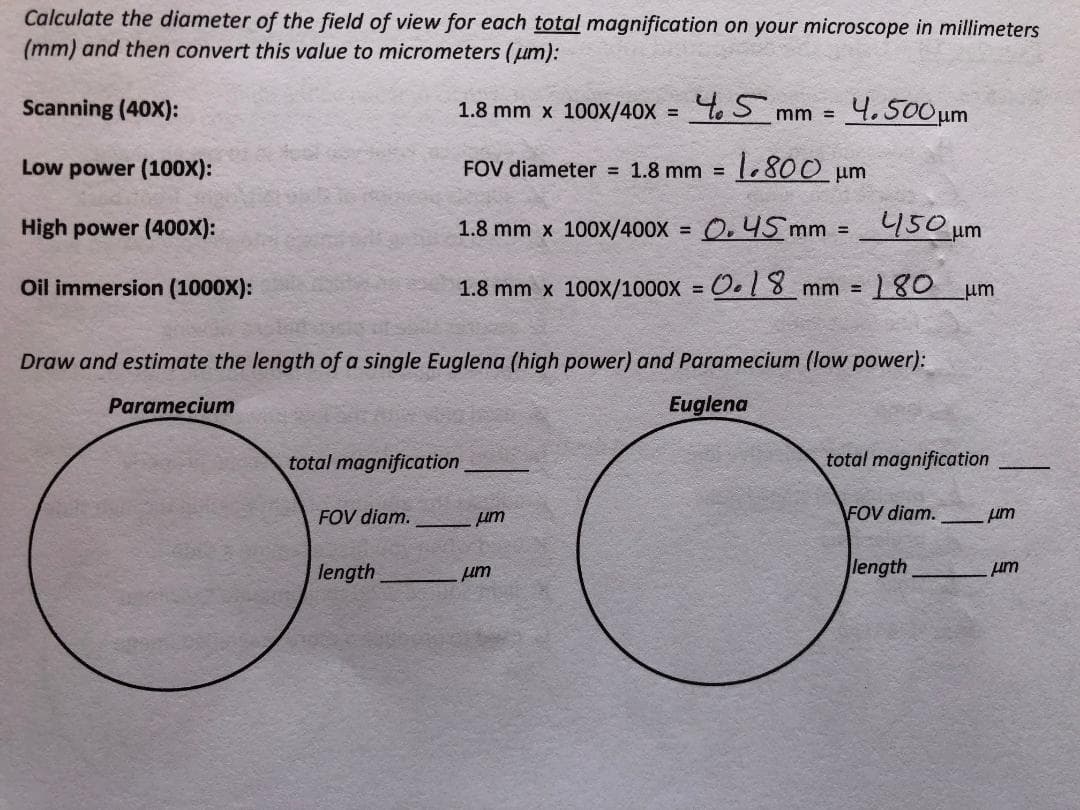Scanning (40X): 1.8 mm x 100X/40x = 5 mm =4.500um Low power (100X): 1,800 um FOV diameter = 1.8 mm = High power (400X): 1.8 mm x 100X/400X = 0, 45 mm 450 um %3D Oil immersion (1000X): 1.8 mm x 100x/1000X = O. 8 mm = 180 um %3D Draw and estimate the length of a single Euglena (high power) and Paramecium (low power): Paramecium Euglena total magnification total magnification FOV diam. um FOV diam. um length length um
Scanning (40X): 1.8 mm x 100X/40x = 5 mm =4.500um Low power (100X): 1,800 um FOV diameter = 1.8 mm = High power (400X): 1.8 mm x 100X/400X = 0, 45 mm 450 um %3D Oil immersion (1000X): 1.8 mm x 100x/1000X = O. 8 mm = 180 um %3D Draw and estimate the length of a single Euglena (high power) and Paramecium (low power): Paramecium Euglena total magnification total magnification FOV diam. um FOV diam. um length length um
Biomedical Instrumentation Systems
1st Edition
ISBN:9781133478294
Author:Chatterjee
Publisher:Chatterjee
Chapter16: Fiber Optics And Lasers In Bioinstrumentation
Section: Chapter Questions
Problem 5P
Related questions
Question
Is it 100X for Paramecium? Is it 400X for Euglena? I don't know how to solve this problem. I don't know what should I draw the picture of the Paramecium and Euglena. Can you explain to me?

Transcribed Image Text:Calculate the diameter of the field of view for each total magnification on your microscope in millimeters
(mm) and then convert this value to micrometers (um):
Scanning (40X):
1.8 mm x 100X/40x = t 5 mm = 4.500um
Low power (100X):
FOV diameter 1.8 mm =
1.800 um
High power (400X):
1.8 mm x 100X/400X =
O,45 mm =450 um
Oil immersion (1000X):
1.8 mm x 100x/1000X = O. 18 mm =
180 um
%3D
Draw and estimate the length of a single Euglena (high power) and Paramecium (low power):
Paramecium
Euglena
magnification
total magnification
FOV diam.
um
FOV diam.
um
length
um
length
um
Expert Solution
Step 1
Euglena is a genus of single cell flagellate eukaryotes. It is the best known and most widely studied member of the class Euglenoidea. The parts of a euglena are:
- Flagellum
- Nucleus
- Contractile vacuole
- Stigma
Paramecium is a unicellular organism with a shape resembling the sole of a shoe. It ranges from 50 to 300um in size which varies from species to species. The parts of paramecium are:
- Cilia
- Contractile vacuole
- Food vacuole
- Macro nucleus
- Micro nucleus
- Oral groove
- Cytoplasm
Trending now
This is a popular solution!
Step by step
Solved in 2 steps with 2 images

Knowledge Booster
Learn more about
Need a deep-dive on the concept behind this application? Look no further. Learn more about this topic, biology and related others by exploring similar questions and additional content below.Recommended textbooks for you


Principles Of Radiographic Imaging: An Art And A …
Health & Nutrition
ISBN:
9781337711067
Author:
Richard R. Carlton, Arlene M. Adler, Vesna Balac
Publisher:
Cengage Learning


Principles Of Radiographic Imaging: An Art And A …
Health & Nutrition
ISBN:
9781337711067
Author:
Richard R. Carlton, Arlene M. Adler, Vesna Balac
Publisher:
Cengage Learning